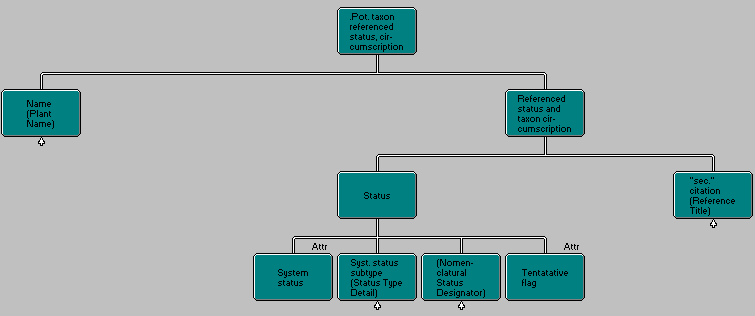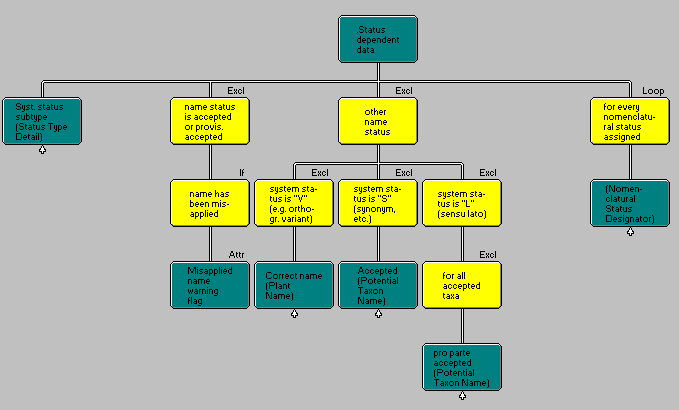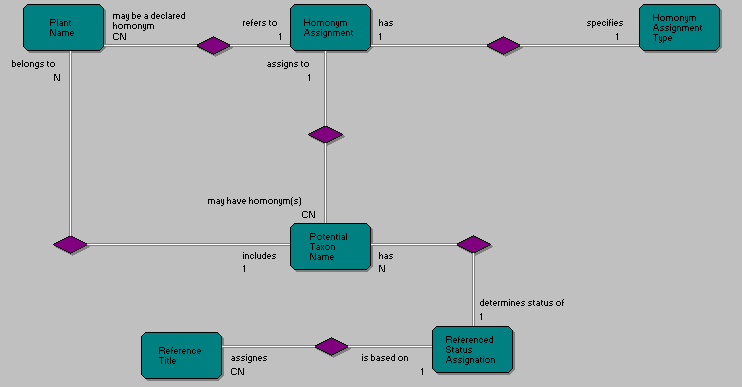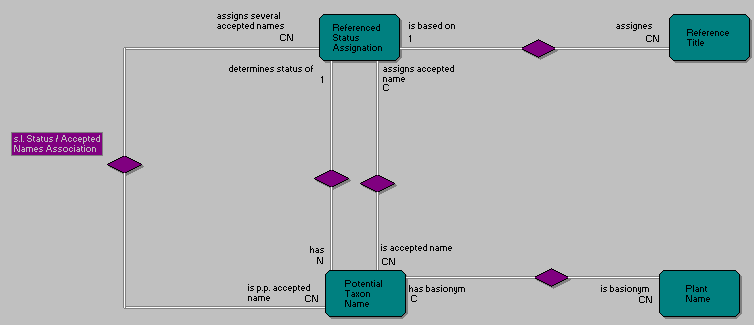

Diagram 6: Data structure of the referenced status and taxon circumscription
The entity "Referenced Status Assignation" links names of potential taxa with their reference. The assignation combines two functions: The reference may on the one hand create a potential taxon, i.e. assign an accepted status to a potential taxon name. On the other hand, it may assign a status implying non-acceptance to existing potential taxa and/or link existing potential taxa and their data to another potential taxon.
The main stati are defined strictly according to the structural function they perform. For example, for the system it is structurally insignificant if a potential taxon A is a synonym of B, or if it is a misapplied name, wrongly used in the place of B. Both are treated as cases of simple system synonymy. On the other hand, a sensu-lato synonym, which may have more than one accepted name, presents structural problems which lead to a different treatment of the relationship, resulting in an additional entity and a different set of integrity rules.
The basic structural status assignments are in the following called system stati. The assignation of a system status may be further defined by a relation to the entities "System Status Detail" and/or "Nomenclatural Status Designator", and/or by means of a modifying flag (doubtful or tentative flag).
The following system stati and status details are defined (letter codes as used in model diagrams):

Diagram 7: Data structure of potential taxon stati
The assignation of a nomenclatural status adds information which may or may not be the actual reason for the status assignation, but which does not have a direct structural impact. Nomenclatural stati have been separated as an additional entity type to facilitate the addition of new data and to allow for multiple designations.

Table 4: Nomenclatural stati
A basionym is just another system synonym and could be treated as a special kind of synonym. However, a basionym also bears strong importance on the composition of the name (as defined above). So, should it be treated as part of the name? Again no; authors may use the name of a combination rightly and cite the wrong basionym. There are two possible solutions to this dilemma:
(a) introduction of a new entity Basionym, which relates to the two names and to the source of the basionym declaration
(b) define the basionym as a property of the potential taxon name rather than the name itself. This is here done.
Plant names in which all name elements are identical are considered homonyms. This is different from common taxonomic usage of the term, which is usually only applied to later homonyms.
Homonymy is important in the process of the creation of a new potential taxon or of a new infrageneric name. The user must be warned as to the existence of the homonyms to avoid erroneous links. The homonym warning flag in entity type „Plant Name" serves to draw attention to the existence of homonyms, it has to be re-evaluated whenever changes in plant names are made.
Because of the existence of non-identical homonyms ("confusingly similar names" based on different types, Greuter, 1994), and because homonyms may be cited in various forms ("non", "vic"), the homonym declaration must be explicit (i.e., not handled only by a flag but by a separate entity).
The declaration of a homonym involves taxonomic judgment, so this is a property of a potential taxon rather than a name. The source of the homonym assignment is given by the circumscription reference of the potential taxon name it is assigned to. The homonym assignment type cites the original form of the homonym citation for the potential taxon (e.g. "non", "vix"; "nec" has to be added by the database program in case that several homonyms are assigned).

Diagram 8: Entities involved in homonym declarations
Structurally, a synonym is similar to a potential taxon, i.e. it consists of a plant name, a status assignation and a reference according to which the synonym status was assigned. However, a synonym cannot have non-taxonomic information related to it, and it must always be connected to a taxon (accepted name).
Rather than creating a separate entity for synonyms, the model treats it as a new referenced status assignation to an existing potential taxon, i.e. synonyms are considered to be a property of potential taxa rather than a kind of names.
For sensu lato synonyms, i.e. synonyms which have more than one accepted name, a separate associative entity is included. This entity could be used to handle all kinds of system synonymy relationships. However, since the great majority of system synonyms involves only a simple relationship, a direct relationship between potential taxon and status assignation was considered justified.

Diagram 9: Entity-Relation model of synonyms
Next chapter; Contents of this article; Complete entity list; References cited; Author information. Last updated: June 23, 1995